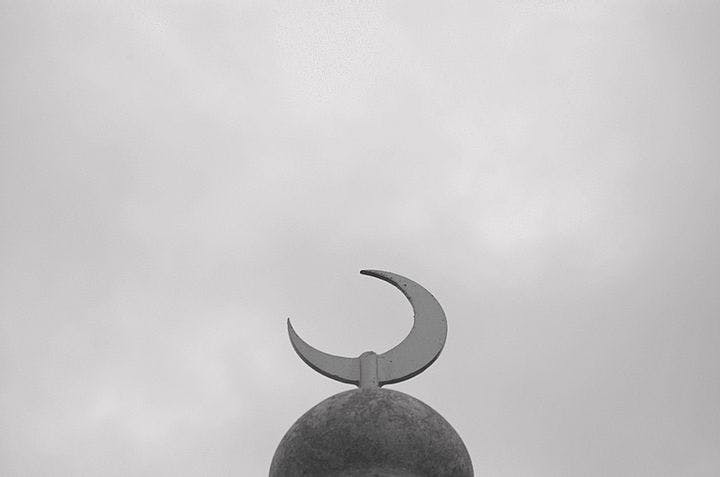Winter 2010
Know Thy Neighbor
– Peter Skerry
Reviewing a new history of Islam in America.
On November 5, a Muslim U.S. Army psychiatrist, Major Nidal M. Hasan, opened fire in a facility at Fort Hood, Texas, killing one civilian and 12 fellow soldiers and wounding many more. This horrific incident is one that many Americans now associate with Muslims, but the book Muslims in America presents a strikingly different image. On the frontispiece is a photo of an attractive woman hugging a young boy, her black hair flowing from underneath a hardhat bearing the emblem of the U.S. Army Corps of Engineers, and her green fatigues emblazoned with an American flag and her last name: Khan.
As this image suggests, Muslims today are adapting to life in America and integrating into American institutions. Muslim women are getting educated and joining the workforce, and while they tend to dress modestly, many do not wear a headscarf. And as Americans are now suddenly aware, a few thousand Muslim Americans serve in the armed forces, including personnel in Iraq and Afghanistan. This assimilation is one facet of the story that Edward Curtis, a professor of religious studies at Indiana University–Purdue University, wants to relate. Curtis, who never explicitly says that he is a Muslim, opens the book by describing his friendly but awkward relations with his neighbor, a Baptist preacher whose son died in Iraq. He wrote this book so that Americans who aren't Muslim “may come to understand Muslim Americans just a little bit better.”
By and large, Curtis achieves his objective. He describes how Muslim slaves brought to America centuries ago from West Africa held on to their religious practices and managed to pass some of them to succeeding generations. Highlighting the diverse origins and other differences among Muslims in America, Curtis tells of one 19th-century convert, a white middle-class Protestant named Alexander Russell Webb. He saw Islam as embodying American principles of rationality and religious pluralism, yet refused to associate with working-class Muslim immigrants from the Middle East and South Asia.
These newcomers, scattered across the country as merchants and peddlers, adapted their faith to their new country—adulterating it at times and reinvigorating it at others. For example, in Quincy, Massachusetts, in 1961, the Arab American Banner Society raised money for a new mosque by holding fundraising picnics where alcohol was served, then took out a mortgage to sustain the mosque. On occasion, the society allowed the mosque to be used for Halloween parties and sock hops. All of these actions violated some aspect of Islamic teaching, and, as Curtis relates, the members were reminded of this when, in the late 1960s, a new wave of immigrants arrived bringing a more orthodox version of the faith.
Today that pattern is being re-enacted, as Muslim newcomers sustained by the revival of Islam overseas seek to shore up the faith of their coreligionists. Yet in the United States the integration of Muslim Americans continues in numerous ways. National fast-food franchises, some owned by Muslims, feature halal dishes (food permitted under Islamic law). Young Muslims born and raised in the United States identify with their faith but also describe themselves as “spiritual but not religious.”
To his credit, Curtis also looks at the less benign side of Islam in America. For example, he traces the rise of the African-American Nation of Islam, whose leader, Elijah Muhammad, preached anti-white racism, discouraged followers from voting or serving in the military, and refused to display the American flag. Yet, as Curtis also shows, Muhammad’s son and successor, Warith Deen Mohammed, renounced his father’s racist ideology, embraced orthodox Sunni Islam, and made sure the flag was flown at every member mosque.
More troubling is Curtis’s account of how, since the 1960s, many Muslim immigrants have brought with them the view that Islam can and should transform America. Some, like the missionary Shamin Siddiqui (who came from Pakistan in 1976) have called on fellow Muslim Americans to exercise their rights as citizens “to transform the country into an Islamic state.”
Curtis is a model of clarity on the details of the Muslim experience in America, but much weaker when it comes to shaping those details into a coherent portrait. And while it’s not unreasonable for him to begin by stating that this is not a book about Muslim terrorists, his failure to reckon with the uncomfortable questions their existence raises further detracts from this portrait. Muslim terrorists act in the name of a religion whose non-extremist mainstream runs against the grain of American society’s liberal values. Americans—Muslim and non-Muslim alike—are sorting out whether and how the battle against such terrorists is to be distinguished from the debate over our cultural and religious differences. Curtis’s goal of explaining Islam to his non-Muslim neighbor is laudable, but his book falls short of addressing, or even articulating, such challenges.
* * *
Peter Skerry teaches political science at Boston College and is a nonresident senior fellow at the Brookings Institution. Reviewed: "Muslims in America: A Short History" by Edward E. Curtis IV, Oxford University Press, 2009.
Photo courtesy of Flickr/Walt Jabsco
